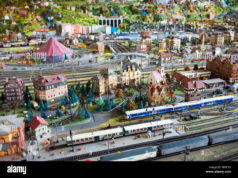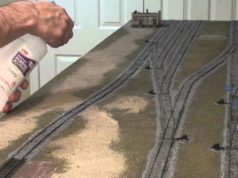In the United States, the standard voltage supplied by an electrical outlet is 120 volts (V) of Alternating Current (AC); the standard is 230 V in the European Union.
Model trains typically run on somewhere between nine and 20 volts, and can use AC or Direct Current (DC), depending on the model. Obviously, the metal tracks model trains ride aren’t pulsing with hundreds of volts of electricity – this is where the important job of a transformer comes into play. Speaking on the simplest level, a transformer takes the power from a wall outlet and “transforms” it into a suitable amount of power to run model trains and the accessories of a layout.
Transformers For Model Trains
Transformers for model trains come in many different styles and forms, but all have at the very least the ability to control the amount of power supplied to the tracks, which will then determine how fast the train will move. Transformers also control which direction the train will move. More advanced transformers are able to power and control layout accessories. As layouts grow, multiple transformers will be required to power distinct electric blocks of track.
When considering which transformer to purchase, keep the basics in mind. First, determine if your train uses AC or DC power and look for the appropriate transformer type. Additionally, if you are using a Digital Command Control (DCC) layout, you will need yet a third type of transformer. Next, determine what features you will need. The most basic transformers will only have a speed and direction control, but depending on your needs you can get units with meters, different operating modes and multiple terminals to add on accessories.
Caution must always be taken when working with electricity, so the next feature to look for begins our look at transformer safety. Ensure that your transformer has a circuit breaker – all new transformers will have a circuit breaker to cut power if the unit becomes too hot, but if you are using a pre-World War II controller, check to see if it is equipped with a breaker. If you find that the unit does not contain a breaker you will want to replace it.
Continuing to look at safety, if you are using an older transformer, check for any signs of wear that may signal danger in the transformer. Any signs of broken or exposed wires, rust or corrosion should send you to a hobby shop or electrician immediately to see if the transformer can be put back into working order or needs to be replaced. That being said, a good transformer can last for 20 or 30 years or more if you take good care of it. Be sure to always use the controller within its power rating, and always unplug the unit when you are not using it. Keep your transformer out of damp areas and definitely away from any standing water.
Finally, with the numerous options of transformers available, shop around to see which best suits your needs. If you are just starting out, your set may have come with a transformer designed to work with the amount of track supplied, which will function fine. As you layout grows, you’ll want to grow your transformer (or number of transformers) with it. Take note of the features available and the ones you need (or would like) and you can quickly find a transformer that fits all of your needs as well as your budget.






